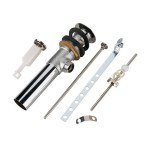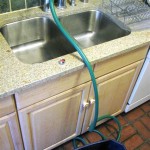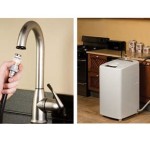How To Clean A Stainless Steel Sink
Stainless steel sinks are a common fixture in many kitchens due to their durability, resistance to stains, and relatively easy maintenance. However, even stainless steel is susceptible to water spots, food residue, and general grime buildup. Regular cleaning is essential not only to maintain the sink's aesthetic appeal but also to prevent the accumulation of bacteria and ensure a sanitary food preparation environment. This article outlines various methods for effectively cleaning a stainless steel sink, from simple daily maintenance to more in-depth cleaning techniques for tackling tougher stains and restoring shine.
Daily Maintenance for Stainless Steel Sinks
Preventative measures are the most effective way to keep a stainless steel sink looking its best. Daily maintenance plays a crucial role in minimizing the need for aggressive cleaning methods. The following practices should become routine:
After each use, rinse the sink thoroughly with hot water. This removes loose food particles and prevents them from drying and hardening onto the surface. Run the water around all areas of the sink, including the corners and edges, to ensure complete removal of debris.
Use a soft sponge or cloth to wipe down the sink after rinsing. Abrasive scrub pads should be avoided for daily cleaning, as they can scratch the stainless steel surface over time. Mild dish soap can be used to remove any oily residue or stubborn food remnants. After wiping, rinse again with hot water to remove any soap residue.
Drying the sink after each use is perhaps the most important step in preventing water spots and mineral buildup. Use a clean, dry microfiber cloth to thoroughly dry the entire sink surface, including the sides, bottom, and around the drain. This prevents the formation of unsightly water spots, which can be difficult to remove if left unchecked.
Avoid leaving acidic or salty foods in the sink for extended periods. These substances can corrode the stainless steel, leading to pitting and staining. Rinse away any spilled liquids or food particles containing acids (like lemon juice or vinegar) or salts as soon as possible.
By implementing these simple daily maintenance practices, the need for more intensive cleaning methods can be significantly reduced, prolonging the life and appearance of the stainless steel sink.
Deep Cleaning Methods for Stains and Grime
Despite consistent daily maintenance, stains and grime can still accumulate on a stainless steel sink over time. To address these issues, several effective deep cleaning methods can be employed. The choice of method will depend on the severity of the staining and the type of grime present.
Baking Soda Paste: Baking soda is a mild abrasive that is effective for removing many types of stains without scratching the sink's surface. To create a baking soda paste, mix baking soda with a small amount of water until a thick paste forms. Apply the paste to the stained areas of the sink, and gently scrub with a soft sponge or cloth. For tougher stains, allow the paste to sit on the surface for 10-15 minutes before scrubbing. Rinse thoroughly with hot water and dry with a microfiber cloth.
Vinegar and Baking Soda: For more stubborn stains, a combination of vinegar and baking soda can be used. Sprinkle baking soda over the entire surface of the sink, then spray with white vinegar. The mixture will fizz and bubble, which helps to loosen dirt and grime. Allow the mixture to sit for a few minutes, then scrub with a soft sponge or cloth. Rinse thoroughly with hot water and dry with a microfiber cloth. Avoid using this method frequently, as the acidity of the vinegar can, over time, dull the finish of the stainless steel.
Lemon Juice: Lemon juice is a natural acid that can be effective for removing water spots and mineral buildup. Cut a lemon in half and rub the cut side over the affected areas of the sink. Allow the lemon juice to sit for 10-15 minutes, then rinse thoroughly with hot water and dry with a microfiber cloth. The lemon juice will also leave the sink smelling fresh and clean.
Commercial Stainless Steel Cleaners: Several commercial stainless steel cleaners are available that are specifically formulated to remove stains and restore shine. When using these products, it is important to follow the manufacturer’s instructions carefully. Choose a cleaner that is specifically designed for stainless steel and avoid using abrasive cleaners, as they can scratch the surface. Always test the cleaner in an inconspicuous area of the sink first to ensure that it does not damage the finish.
Hydrogen Peroxide and Baking Soda: A combination of hydrogen peroxide and baking soda can be effective for removing stubborn stains, especially those caused by coffee or tea. Mix hydrogen peroxide with baking soda to create a paste and apply to the stain. Let it sit for a few minutes, then scrub gently with a non-abrasive sponge. Rinse thoroughly.
After using any of these deep cleaning methods, it is important to thoroughly rinse the sink with hot water and dry it with a microfiber cloth. This will prevent the formation of water spots and ensure that the sink is left clean and shiny.
Preventing Scratches and Maintaining Shine
While stainless steel is durable, it is susceptible to scratches and dulling of its shine if not properly cared for. Implementing preventative measures and using appropriate cleaning techniques can help maintain the sink's appearance and prevent damage.
Avoid Abrasive Cleaners and Scrub Pads: Abrasive cleaners, such as scouring powders and steel wool, can scratch the stainless steel surface. Always use soft sponges, cloths, or brushes for cleaning. If a more abrasive material is needed for a particularly stubborn stain, test it in an inconspicuous area first and use it sparingly.
Use Sink Grids: Place a sink grid in the bottom of the sink to protect it from scratches caused by pots, pans, and other dishes. Sink grids also help to elevate items, preventing them from sitting directly on the sink surface and potentially causing stains or corrosion.
Wipe in the Direction of the Grain: Stainless steel has a grain, which is the direction of the fine lines on the surface. When cleaning or polishing, wipe in the direction of the grain to minimize the appearance of scratches. Wiping against the grain can exacerbate existing scratches and create new ones.
Stainless Steel Polish: To maintain the shine of a stainless steel sink, use a stainless steel polish regularly. Apply the polish according to the manufacturer’s instructions, and buff the surface with a soft cloth. Stainless steel polish helps to protect the sink from stains and water spots, while also restoring its luster.
Oil Treatment: Applying a small amount of mineral oil or olive oil to the sink after cleaning can help to protect it from water spots and maintain its shine. After the sink is clean and dry, apply a few drops of oil to a soft cloth and rub it over the entire surface. Wipe away any excess oil with a clean cloth. This creates a protective barrier that repels water and prevents staining.
Avoid Harsh Chemicals: Avoid using harsh chemicals, such as bleach or ammonia, on stainless steel sinks. These chemicals can corrode the metal and damage the finish. If using bleach, dilute it heavily and rinse thoroughly.
By following these preventative measures and using appropriate cleaning techniques, the stainless steel sink can be kept looking its best for years to come. Regular maintenance and careful cleaning will help to prevent scratches, stains, and dulling of the shine, ensuring that the sink remains a functional and aesthetically pleasing part of the kitchen.
Ultimately, the key to properly cleaning and maintaining a stainless steel sink lies in consistent, gentle care. By adopting a routine of daily rinsing and drying, periodic deep cleaning with appropriate materials, and careful attention to avoiding scratches and corrosion, the sink can remain a hygienic and attractive element in the kitchen for an extended period.

Cleaning A Stainless Steel Sink Going Green With Lisa Bronner

The Secret To Cleaning Stainless Steel Sinks Like A Pro

How To Clean Kitchen Sink Stainless Steel

How To Maintain Your Stainless Steel Sink

How To Clean A Stainless Steel Sink And Make It Shine Simple 3 Step Solution With Ingredients Found Around Your Home The Thrifty Couple

Clean A Stainless Steel Sink Easily With Wd 40 Australia

How To Clean Stainless Steel Kitchen Sink Like A Pro Review Youtube

How To Clean Stainless Steel Sink Stains Naturally With Baking Soda Vinegar

How To Clean A Stainless Steel Sink So It Looks Good As New

How To Clean Chemical Stained Stainless Steel Kitchen Sink







